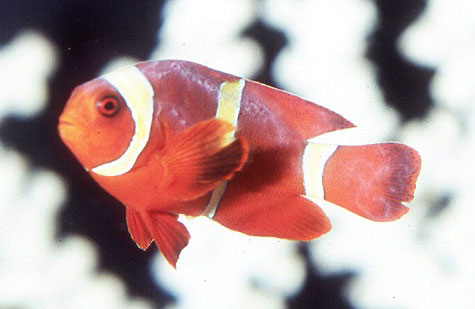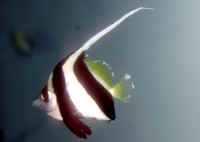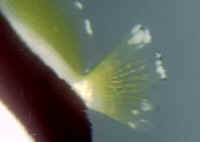

|
|
|
#1
|
|||
|
|||
|
true perc with white lesion
First of all, I apologize that I don't have a photo. That being said, a friend of mine gave me a pair of true percula anemonefish 2 nights ago. They were in his tank for about 4 weeks before I got them, and his tank had a recent crash. When I picked them up from him, they were fat and happy. Unfortunately I don't have a Q-tank but he's an experienced reefer and I figured 4 weeks in his tank was Q-enough. Once in my tank I fed them and they ate hardily. During the feeding, I noticed that the larger one (the female, I guess) had a 3 x 3 mm white lesion on her left side near the belly, just behind the gill. Initially I thought this was a chunk of squid that stuck to her during the feeding, but the next day (yesterday) it was still there. Last night the fish again fed quite well, and they both remain active and with non-labored breathing. My friend said he didn't see this lesion when it was in his tank, but I doubt the fish aquired it in the short period of time it took me to drive it from his house to mine. I looked up clownfish diseases in the "clownfish" book, but didn't see anything in there that was similar to what I'm finding. Any ideas? Should I do a FW dip?
tank info: 30g 30lb cured LR 2" sand bed T 79-81 SG 1.025 nitrates 0 NH3 0 Ca ~360 alk 2.98
__________________
The Dude abides |
|
#2
|
|||
|
|||
|
Here's some more info.
I don't think this is ick or lymphocystis. It may be Amyloodinium but I can't find a pic of this disease. The appearance matches the description somewhat, although the symptoms (scratching, heavy respirations, floating near top of tank) don't fit. more tank info: running x 2 months pH 8.4 many inverts (snails, hermits, peppermint shrimp, pistol shrimp, fighting conch, mithrax crab) no other fish
__________________
The Dude abides |
|
#3
|
|||
|
|||
|
As you've guessed, there is a lot written on-line about Marine Velvet, but few diagnostic pictures. Here are some links with pictures:
This is mostly text, but includes a photo (unfortunately not very good). http://www.wetwebmedia.com/amylloodiniumart.htm These mostly feature FW Velvet - which is similar. http://www.aquaculture.bz/fish-disea...t-Disease.html http://www.fishpalace.org/Disease.html#Velvet Also, might be Brooklynella? http://www.saltwaterfish.com/vb/showthread.php?t=127010 Have a very close look, it sounds like lymphocystis, but cross check with the photos in the Brooklynella link. I wouldn't dip the fish until you have a more definitive idea of what the problem might be. |
|
#4
|
|||
|
|||
|
Thanks for your help. After looking at the pics, it doesn't seem at all like brooklynella and seems more like lymphocystis than anything else, but not exactly. It's only a single lesion. If it is, then I guess the treatment is good water quality and good nutrition, right?
What's the harm in doing a FW dip? I read that it's a good way to test for, and potentially treat amyloodinium. http://www.petsforum.com/personal/tr...fwdiptest.html
__________________
The Dude abides |
|
#5
|
|||
|
|||
|
Brooklynella
 Lymphocystis  
__________________
Steven Pro, yep that is my real name. 19th Annual Marine Aquarium Conference of North America (MACNA) in Pittsburgh, PA September 14-16, 2007 |
|
#6
|
|||
|
|||
|
Hey Dude (couldn't resist),
Lymphocystis is caused by a virus and is brought on by stress - because it's caused by a virus it's basically untreatable. Dipping your fish in FW will not affect lymphocystis, but will stress the fish - so in effect could make matters worse. If it's Velvet (Amyloodinium) FW dips may dislodge parasites, but generally won't affect encysted stages. You would really need to administer several dips but, more importantly, you need to think about your system, which would be acting as a reservoir. If it's Brooklynella, the best treatment is a formalin bath/dip. So, I'm not sure a one-off FW dip is really going to do much. You really need to figure out what the problem is. What your fish carefully, make sure you water quality is spot on and provide good nutrition. You may find out it's none of the above. However, if it is something more insidious you best chance of success is to apply the correct treatement. Steve, nice pics⦠|
|
#7
|
|||
|
|||
|
Bad news ... last evening the fish was swimming quite slowly and breathing rapidly. I checked on her at about midnight and she was laying on her side at the bottom of the tank. This morning she was still there but looked very bad - labored breathing and little else with regard to motion. I provided a feeding to the tank and she did not leave her spot on the bottom. I fear that when I get home she will be either dead in the tank or consumed by my invertebrates. The male, on the other hand, is quite healthy and looks good. I recontacted the previous owner of the fish and he admitted to seeing the same lesion that I described but it didn't seem to affect her, so he did nothing about it. Perhaps this was/is a viral illness that had stabilized, but the stress of moving her to my tank has been too much for her (?). I'm deeply saddened by this and hope she turns around but I'm not optimistic. By the way, I retested all parameters last night and there are no changes from my previous post. She has no new lesions on her skin, just the one involving the left gill.
__________________
The Dude abides |
|
#8
|
|||
|
|||
|
Worse news ... she died today. My wife called from home and said she was belly up at the bottom. There were no new lesions on her and she remained plump. It didn't look at all like the pics I've seen of brook, marine ick or lymphocystis.
The male is doing well, but I feel horrible about breaking up this happy pair. Is it possible that it was one of these diseases and just didn't resemble the above photos or others that I've seen?
__________________
The Dude abides |
|
#9
|
|||
|
|||
|
I provided the clowns and will provide a little more background so hopefully someone can jump in with a similar experience or at least some kind of answer.
I purchased the pair 4 months ago, not 4 weeks ago, and neither clown have developed any disease that I have been able to see externally. I work at a LFS and therefore have seen clowns come in with brook, ich, malnutrition, etc... and these clowns really were in tip top shape. They ate a blended mix (the exact same batch my friend Dudester uses, I made it with him) and up until this point have been perfectly healthy. I gave them up, when my RBTA wandered into a powerhead, setting about a chain of events, that ended 3 days ago with dead acros and cloudy water. The clowns were doing great and eating normally up until I gave them to Mike. I also noticed the white (lesion) when I had her and it never seemed to affect anything. It really did look like either an abnormality with her gills or a piece of squid stuck on her. What would cause a clown that has been perfectly healthy for 4 months, to go belly up in 3 days, with no signs of physical problems? The only thing I can think of is cirolanid isopods... Any ideas from anyone?? |
|
#10
|
|||
|
|||
|
It's been 6 days since the passing of my female perc, and the male continues to do well, although I suspect he's lonely.
Let me rephrase that ... I think he's doing OK. I didn't mention it above, but when I got the pair, the male also had a small white lesion at the top of one of his gills, much smaller than the one I described on the female. He continues to eat quite well and his respirations are not labored, although now I see a few white spots on his dorsal fin and the area on his gill is a little larger. It now looks more typical of lymphocystis according to the photos above (thanks StevenPro). I went ahead and bought a QT last weekend (I know, I should have done this a long time ago) and placed the filter sponge in my sump. I'm thinking of getting a juvenile perc to add to my tank and hopefully they will become a pair. I intend to quarantine the new fish for 4-6 weeks at SG 1.009. Questions: 1. Should the (apparent) lymphocystis infection of my current fish prevent me from having any new additions to my tank? 2. Should I, instead, place my current fish in the QT to halt any continued spread of an infection in my display tank, and hold off on getting the new clown? 3. Since my current fish behaves like he's well, should I place him AND the new juvenile into the QT together to isolate them and potentially improve their chance of pairing up?
__________________
The Dude abides |
|
#11
|
|||
|
|||
|
Dudester - here are my thoughts on the Q questionsâ¦
1. No. Lymphocystis is quite common. You normally only see it if you fish are stressed. If you have good water quality and nutrition it should resolve on it's own. 2. Yes. I would suggest putting your existing fish in Q. Since you don't have a definitive diagnosis - this is a precaution. Hold the fish in Q and observe what happens. If after 3-4 weeks the "lesion" doesnât progress and the fish seems fine (normal behaviour, eating well) then you can move him back. If it turns out it's something else, you will be in a better position to deal with it. 3. No. I would wait until your first fish is out of Q before putting the new one in. Put the new one through Q on it's own. Putting both in at the same time will only complicate things if the new one brings something in that is completely different (i.e. new pathogen). I think that disadvantages of the disease potential outweigh the advantages of getting them to pair up. Actually, I'm not sure that having them in close proximity in Q will facilitate pairing. I would have thought the chances of pairing would be just as good in your main system. You may be working from a wrong assumption - although I'm not to familiar with clown behaviour so take this last thought with a grain of salt. The goal should be to ensure they are healthy first (and that you protect your main system) and then worry about getting them to pair up. |
|
#12
|
|||
|
|||
|
Thanks, Rondelet, for your comments. I would like to inquire further on item #2. Naturally I don't disagree with you, since I posed the question. However, I'm concerned with the stress that will be caused by capturing him and releasing him into my QT, followed by another capture and release into my main tank. Looking back, I feel that this (stress) is what led to the death of my female, since she was quite well in my friend's tank for 4 months prior to being placed into my tank. Does this sound like a valid concern?
Quote:
I agree with you completely that the health of the fish, and the health of the system, outweighs my desire for them to pair up.
__________________
The Dude abides |
|
#13
|
|||
|
|||
|
Dudester,
Truth is, it's a tough call (and therefore valid question). I agree that the stress of moving the fish around and being held in quarantine will play a significant role in the outcome. One qualifier I should have asked is what else you have in the tank and how easy it would be to remove the fish. Also, it really depends on how good you are at being able to pick up on the clinical signs of disease. My suggestion to move the fish to Q was based on the assumption that some unidentified disease process was taking place. It is likely, but not certain, that something is lurking around in the background that you might have to treat the fish for. I don't think quarantine is the issue here. (Perhaps a terminology faux pas on my part - I call all tanks used to keep fish separate for holding, treatment, or quarantine "Q" tanks). If you are confident that perhaps this is not the case and there is a good chance you won't have to treat the fish, then I would agree with you: that the stress of the move and holding the fish in your "Q" tank may not be worth it. However, you still don't know what killed the other fish. Could have been stress - or it could have been something else. My concern therefore was based on preventing an unknown pathogen from infecting your new fish when it comes out of quarantine. I'm very big advocate of using good water quality and nutrition to allow fish to heal themselves and fight disease, so you're not off-base here. However, "stress" may be a little over-rated in this situation. If your fish is healthy and the water quality is good, moving the fish 2x shouldn't stress it out too much. I've put fish through a lot more without watching them die mysteriously. So, the logic is that if the fish is healthy the move shouldn't cause a problem (no harm done). But if the fish isn't, then you will be in a better position to treat it (future harm avoided). Either way you (and your fish) should win. In theory....but don't forget, theory doesn't always work in practice! |
|
#14
|
|||
|
|||
|
Quote:
Quote:
I think I'll leave my current fish in the tank, and I'll get a juvenile and quarantine it for a full 6 weeks. If my current perc survives the 6 weeks in my tank (he'll probably be a "she" by then), then likely he'll be free of any diseases and I can add my new fish, correct? If this sounds illogical please guide, or shove me in the right direction.
__________________
The Dude abides |
|
#15
|
|||
|
|||
|
Dudester,
Sounds like a plan. With only the one fish in the tank, there's less risk it could have picked something up (or transmit something). It's also a small enough tank so that it should be easy to get the fish out. However, if your other fish died and now the clown - suddenly upon entry - might suggest something more simple like a water quality hiccup (although your water parameters and the fact that your frog spawn sounds ok would suggest otherwise). Usually when a fish dies for no "apparent" reason, and has no obvious clinical signs - it's usually not due to a pathogen. As for what might be lurking - without seeing the fish it's next to impossible to tell from where I'm sitting. Looking back over the post - is it possible that you have some sort of invertebrate predator that came in on your LR and attacked your fish in the night (e.g. bristle worm)? An off the wall idea you might want to explore further. I would think what you've suggested sounds like a good course of action. |
|
#16
|
|||
|
|||
|
Update for anyone interested:
I got a new juvenile true perc and placed it in the QT just over 2 weeks ago. It's growing quite well, has a fat belly, and appears very happy and healthy. The white lesions on the fish in my display began to increase initially and spread onto his tail and dorsal fin. Going on the assumption that he had lymphocystis, I started doing weekly (instead of every other week) water changes (~15% system volume) to improve water quality. His (soon to be "her") white lesions have regressed significantly and I believe he's much healthier. I hope that he and the fish I placed into quarantine pair up once it's added to the display  . .
__________________
The Dude abides |
|
|